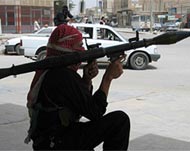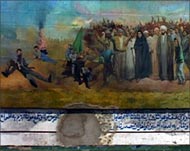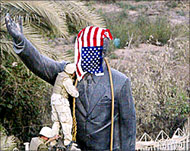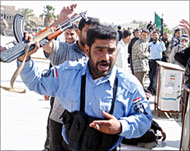Sadr City: Support from the poor
In the main square of Baghdad’s largest Shia ghetto, an elderly man in the worn uniform of the former Iraqi air force directs donkey and car traffic with a ping-pong paddle.

Sadr City, once called Saddam City, has always been on the neglected margins of Iraq’s power centre and capital.
Piles of trash and long pools of raw sewage line the boulevards, while battered looking men stand on corners with shovels waiting in the hot sun for work.
Living deep in every alley are the families of martyrs from the eight-year Iran-Iraq war, from riots against Saddam Hussein and from executions on the gallows of Iraq’s prisons.
Every billboard, painting and poster advertises them – from shaikhs, Ayat Allah clerics and religious students killed by the former regime, to Ali and Hussein, the 7th-century father and son – cousin and grandson of the Messenger Muhammad – who inspired the Shia sect of Islam.
Many martyrs
But the largest portraits are reserved for the one after which Sadr City is named – Muhammad Sadiq al-Sadr, a snowy bearded Ayat Allah who launched a revolutionary Shia movement here in the 1990s.
 |
|
A member of al-Mahdi Army |
Posters of his son, Muqtada al-Sadr, now wanted by occupation forces, are usually plastered nearby.
The support for al-Sadr and his son runs as deep as the poverty, gruelling lifestyle and sacrifices do for the citizens.
Sadr City has its origins in the masses of destitute Shia farmers who fled the feudal conditions of Iraq’s countryside in the last century, creating a ring of slums around Baghdad.
In 1963, Abd al-Karim Qasim, the founder of the modern Iraqi Republic, created the neighbourhood as a dignified alternative for the masses of urban poor and dubbed it Madinat al-Thawra – Revolution City.
Under class
Under ensuing governments, Sadr City’s Shia made up to a third of Baghdad’s population, but held few positions of power and were disproportionately represented in Iraq’s unemployment rolls, prisons, and the frontlines of its wars.
The people first turned to communism to address their social woes, then to the homegrown revolutionary ideology of Ayat Allah Muhammad Baqir al-Sadr, executed by the government in 1980, and his cousin Ayat Allah Muhammad Sadiq al-Sadr assassinated in 1999.
Both men had studied for years under the leader of the Iranian Revolution Ayat Allah Khomeini.
 |
|
Support for the al-Sadr family |
According to Shaikh Abd al-Zahra, the Imam of al-Hikma mosque in Sadr City, Muhammad Sadiq al-Sadr was revolutionary because he called for the formation of a just Islamic state. He won support from the impoverished because he called the clergy to a leading role against social injustice.
Most importantly, he dared to stand up for them to Saddam Hussein.
“Al-Sadr demanded the government release prisoners, because many of our youth and men of religion were just rotting in jail and no one knew their fate,” says Abd al-Zahra.
“He called state ministers to ask for forgiveness. He used to chant: ‘No, no to Satan, no, no to the unjust one!’ And everyone knew that what he meant by Satan was Saddam.”
Executions
In 1999, Ayat Allah Muhammad Sadiq al-Sadr was assassinated after Friday prayers in the city of Najaf.
 |
|
A billboard depicts the protests of |
As news reached al-Sadr’s loyalist enclave in Baghdad, tens of thousands of poor Shia converged on al-Muhsin mosque in Sadr City in mourning. Security agencies fired into the air to break up the crowd, and mourners turned into an enraged mob, attacking them with rocks and their bare hands.
Before long, more than 1000 Baath party and security forces were on the scene with tanks and APCs, firing randomly on the mostly unarmed crowds.
Security forces closed al-Muhsin mosque, welded its doors shut and launched a massive campaign of arrests and executions.
No one knows how many died overall but residents say the events touched all families and left victims in every street of the city. Similar scenes were repeated in Najaf and other cities of southern and central Iraq.
A militia born
The protests in Sadr City began at 10.30am and were over by noon but left a deep historical impression and served as a turning point for followers of al-Sadr line, sealing their allegiance to the Ayat Allah and militarising the movement.
 |
|
There is growing opposition among |
After Baghdad’s fall last year, Muqtada al-Sadr emerged as a militant voice against the occupation.
Though most viewed him with scepticism, in Sadr City the mantle of his father slipped easily on to his shoulders.
Along with Muqtada, another child of the protests and long years of Baath rule surfaced – Jaish Al-Mahdi, the thousands-strong militia of the poor, unemployed soldiers and religious students fiercely loyal to al-Sadr family.
Fresh martyrs
Down a beaten mud alley, where black banners announce the recent deaths of martyrs, Ali al-Muraidi, a retired porter, sits looking at photos of his two dead sons Husayn and Qasim.
The young men were typical al-Sadr followers.
Impoverished porters like their father, they stood for hours in the market leaning on pushcarts, waiting to be paid a few dinars to move goods.
With no money in their pockets and no weapons in their hands, they rushed into the street at the first sound of gunfire.
|
“My sons were poor Ali al-Muraidi, |
“My sons were poor and all they had left was heaven,” says Ali, weak-eyed and fiddling with their ID cards.
His voice is hoarse and broken. “They didn’t even have guns and the army opened fire on them randomly. But we know that the martyr who stands up to the unjust one goes to paradise with the prophets on a level near God”.
The unjust one Ali speaks of is not Saddam Hussein, nor did his sons die in the 1999 protests.
Husayn and Qasim died on 5 April 2004 in a new protest over several days of armed clashes with US occupation forces in the heart of Sadr City and across other Shia neighbourhoods and cities.
The clashes were triggered by the forced closure of al-Sadr’s newspaper and had led to the death of more than 100 Iraqis and scores of US occupation troops in Sadr City alone.
Tough lessons
When the US military first entered Baghdad, Ali and the people of al-Sadr City hailed them as heroes and liberators.
But a year later, this sentiment has reversed and a new saying is heard in the streets: “The student left and the teacher came.”
Al-Sadr City officials, Iraqi police and residents complain that US forces launched a campaign of arrests of youth and men of religion, raids, curbs on freedom of expression, random killings, and oppression reminiscent of Saddam Hussein.
 |
|
Ali al-Muraidi, with remaining |
Like the government, they also neglected city services in the area including sewage maintenance, jobs creation, water and electricity.
When US occupation officials vowed to kill or capture Muqtada al-Sadr and to destroy al-Mahdi Army, many felt a sense of deja vu. What differs now, say residents, is their reaction to the situation.
“We didn’t resist enough during Saddam’s time and we kept saying to ourselves: ‘We’re guilty, we’re guilty, we didn’t stand with Sayyid al-Sadr against the tryant’,” says Muhammad, caretaker of the re-opened al-Muhsin mosque and a witness to the events of 1999.
“But now, no, we won’t be guilty again. Now, we have Jaish al-Mahdi.”
Local security
Even the security arm charged with maintaining public order in Sadr City – the Iraqi police – appears as loyal to al-Sadr, to his wanted son and to the outlawed Jaish al-Mahdi as the area’s ordinary residents.
 |
|
Al-Mahdi Army finds support |
“If there are any more clashes here, we won’t intervene,” says Colonel Maruf al-Lami, head of Sadr City’s police directorate: “We’re from the people of this city and the people in Jaish al-Mahdi are our relatives. We can’t fight our brothers and neighbours.”
Top police officials in Sadr City describe the militia as a “cooperative force” in keeping order. And beat cops talk about quitting their jobs and joining Jaish al-Mahdi if US forces move on al-Sadr’s son.
“I’m one of al-Sadr’s followers,” says Aqil, an officer on patrol in the area, “and my brother is in Jaish al-Mahdi. And this is my cousin,” he says pointing as he drives past a large painting of a martyr. “He was one of the heroes of the 1999 Intifada. I’m not a member of Jaish al-Mahdi now, but when the time comes, I will be. All of us will be.”
House of al-Sadr
Most of Sadr City’s residents continue to follow the fatwas and religious declarations of Muhammad Sadiq al-Sadr even though he is dead.
His memory, more than any other, is a touchstone for the community, a reminder of courage and collective loss.
|
“Muqtada lived the tragedy of the people Muhammad, |
And the emotion towards al-Sadr extends protectively to his son.
“Muqtada lived the tragedy of the people as did his father,” says Muhammad of al-Muhsin mosque. “The people who lived here and suffered, who were dispossessed and exhausted, who fought the wars, who were denied education and jobs and lost loved ones and everything during the time of Saddam.
“He is the son of the people. The father died and now we only have one left. When I think they could kill him, I see the fire of hell in my eyes.
“He’s the son of the revolutionary; the only one who stood up to Saddam Hussein,” echoes Aqil the police officer. “His family sacrificed and was killed off. Now, Muqtada is all that remains for us.”